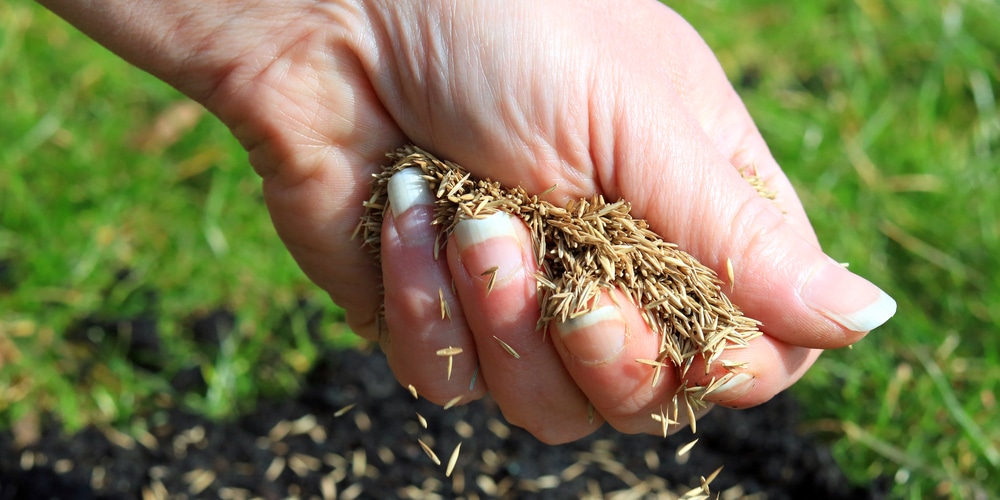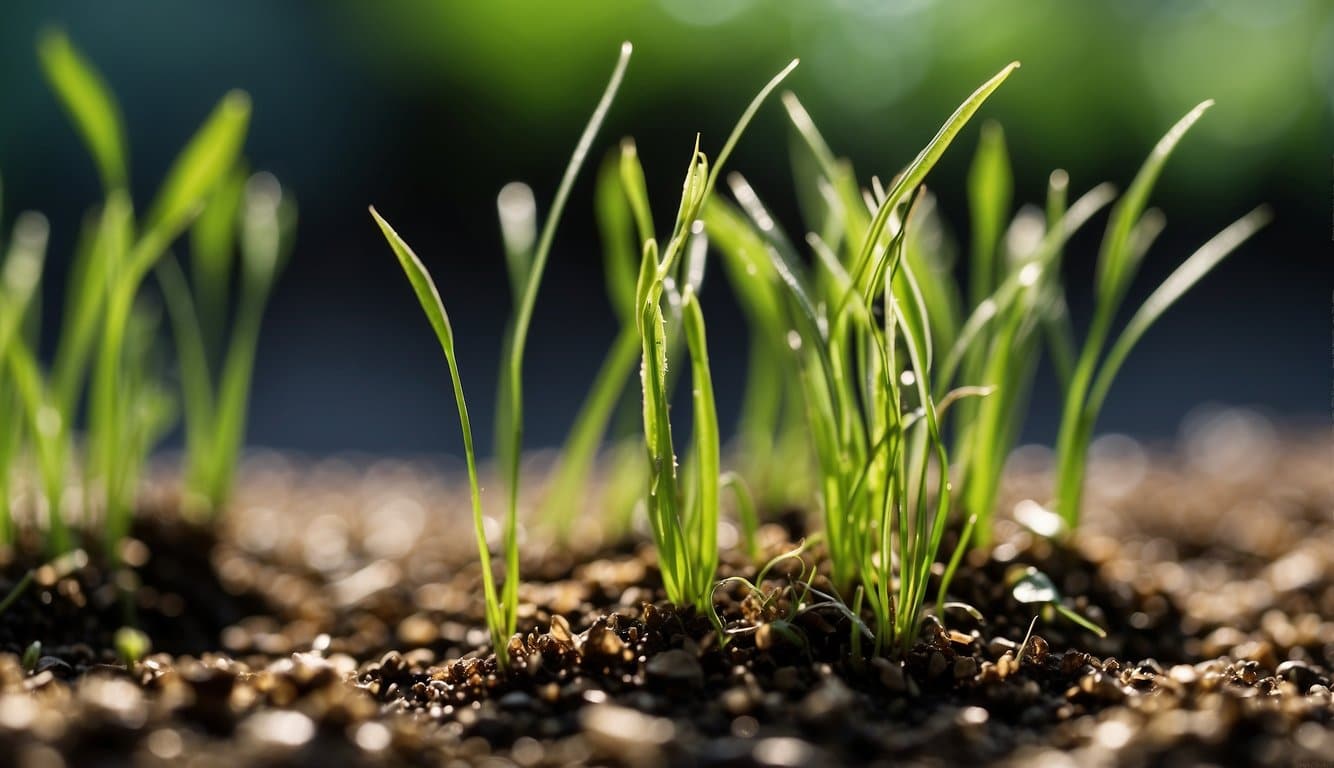What to Do If Your Grass Seed is Not Growing
Step 1: Assess Environmental Conditions
- Question: Is the area receiving adequate sunlight?
- Yes: Proceed to Step 2.
- No: Consider trimming nearby trees or shrubs to allow more sunlight to reach the grass.
Step 2: Evaluate Soil Quality
- Question: Is the soil healthy and well-draining?
- Yes: Proceed to Step 3.
- No: Test the soil pH and texture. Amend as necessary with organic matter, lime for acidic soils, or gypsum for compacted soils.
Step 3: Check Watering Practices
- Question: Is the grass receiving sufficient water?
- Yes: Proceed to Step 4.
- No: Adjust watering frequency and duration. Consider installing irrigation systems or using soaker hoses to ensure even watering.
Step 4: Assess Fertilization
- Question: Has the grass been fertilized appropriately?
- Yes: Proceed to Step 5.
- No: Apply a balanced fertilizer according to soil test recommendations or general guidelines for your grass type.
Step 5: Identify Pests and Diseases
- Question: Are there signs of pests or diseases on the grass?
- Yes: Identify the specific pest or disease and treat accordingly with appropriate pesticides or fungicides.
- No: Proceed to Step 6.
Step 6: Consider Traffic and Compaction
- Question: Is the area heavily trafficked, leading to soil compaction?
- Yes: Aerate the soil to improve air and water penetration.
- No: Proceed to Step 7.
Step 7: Monitor Growth and Health
- Action: Observe the grass over time to track any improvements or continued issues.
- Record Keeping: Keep a gardening journal to track changes and interventions made.
Step 8: Seek Professional Advice
- Question: Have you tried multiple interventions without success?
- Yes: Consult with a professional landscaper, agronomist, or extension agent for expert advice and assistance.
- No: Continue monitoring and adjusting your lawn care practices based on observations.
Step 9: Re-evaluate and Adjust
- Action: Periodically reassess the lawn’s condition and adjust maintenance practices as needed to promote healthy growth.
- Persistence: Sometimes, it may take time and experimentation to identify and address the underlying issues affecting grass growth.
Additional Tips
- Proper Mowing: Ensure grass is mowed at the correct height for its species to promote healthy growth.
- Overseeding: Consider overseeding thin areas to encourage denser grass coverage.
- Weed Control: Keep weeds in check, as they can compete with grass for resources.
When you scatter grass seed across your prepared soil, a silent countdown begins. Like a painter with a blank canvas, you’ve taken the first step towards transforming a barren patch into a lush, green landscape.
The anticipation of seeing those first fragile sprouts emerge brings with it a bevy of questions, chiefly among them: how long will it take for the grass seed to grow?
The truth is, the germination time of grass seed can vary widely depending on several variables, including the type of grass, the prevailing weather conditions, and the care you provide.
The type of grass you’ve chosen plays a crucial role.
Cool-season grasses, such as Kentucky bluegrass, typically take 14-30 days to germinate, while warm-season varieties like Bermuda grass might sprout anywhere from 10 to 30 days.
Your commitment to creating the ideal environment—well-prepared soil, consistent moisture, and the right amount of sunlight—is essential for speeding up the germination process.
Remember, the right care after sowing can make all the difference, setting the stage for those first green shoots to push through the soil.
As you eagerly await the transformation of your lawn, it’s vital to maintain a balance in the growing conditions.
Ensuring adequate moisture without waterlogging the seeds, keeping the soil at a favorable temperature, and avoiding any traffic on the newly planted area are all key factors.
Furthermore, detailed guides, such as those provided by The Spruce on how to plant grass seed, can be invaluable in helping you navigate the fine details of lawn establishment.
Patience coupled with careful attention will soon result in a robust and vibrant lawn that mirrors the time and effort invested.
Understanding Grass Seed Germination
Grass seed germination is the process by which a grass seed begins to grow into a new plant. Factors that influence germination include seed type, soil conditions, temperature, and watering practices.
As you embark on establishing your lawn, it is crucial to grasp the basic timeline and requirements for successful grass seed germination.
Key Stages of Germination:
- Imbibition: Grass seeds absorb water and begin to swell.
- Activation: Seed metabolism kickstarts, leading to increased enzyme activity.
- Emergence: The seed’s radicle (primary root) breaks through the seed coat.
Germination Timeframe:
Different types of grass seeds have varying germination times. For example:
| Grass Type | Germination Timeframe |
|---|---|
| Buffalo Grass | 14 – 30 days |
| Centipede Grass | 14 – 21 days |
| Bermudagrass | 10 days – 1 month |
| Zoysia Grass | 14 – 21 days |
| Kentucky Bluegrass | 14 – 30 days |
Temperature Considerations:
Grass seeds typically germinate best when soil temperatures range between 50°F and 65°F. This germination timing must be factored into your planting schedule.
Watering:
Maintaining consistent moisture is imperative during the germination period. Light, frequent watering helps prevent the shallow-rooting seeds from drying out.
Factors Affecting Grass Seed Growth
When nurturing new grass, understanding the intricate balance of conditions needed for seeds to flourish is crucial to successful lawn establishment.
Seed Variety
Your choice of grass seed greatly influences the germination time and overall growth.
For example, the germination time for buffalo grass ranges between 14 and 30 days, a window similar to that of Centipede grass. Conversely, Bermuda grass can sprout anywhere from 10 days to a month.
Soil Conditions
The temperature and nutrient profile of your soil are gatekeepers to seed growth.
For optimal germination, soil temperatures should be aligned with the needs of your specific grass variety, and the soil must be rich in essential nutrients and minerals.
Planting Depth
Plant your seeds at the correct depth to ensure they receive the right balance of moisture and warmth.
Seeds sown too deeply may struggle to reach the surface, while those too shallow may not establish properly or could be washed away.
Watering Practices
Regular, gentle watering is necessary to keep the soil consistently moist.
Overwatering, however, can lead to seed rot or displacement, so aim for a balance that keeps the soil damp but not sodden.
Climate and Season
Grass seeds thrive in specific climatic conditions.
Both warm and cool-season seeds have distinct periods of the year when the conditions are most favorable for growth.
Make sure to plant your seeds during a season that matches their temperature preferences for best results.
Germination Time Frames
The period it takes for grass seed to sprout, known as germination, varies widely depending on the type of grass. You’ll see a range from a few days to a couple of weeks for germination to occur, with specific timelines for cool and warm season grasses.
Cool Season Grasses
Cool season grasses thrive in areas with cold winters and hot summers and generally germinate more quickly.
Perennial ryegrass, one of the fastest germinating grass seeds, typically sprouts within 5 to 10 days. Another popular choice, Kentucky bluegrass, takes a bit longer, generally 14 to 30 days to germinate. Here’s a quick reference:
- Perennial Ryegrass: 5-10 days
- Kentucky Bluegrass: 14-30 days
Warm Season Grasses
On the other hand, warm season grasses prefer warmer climates and have slightly different germination times.
Bermudagrass seeds generally start to germinate between 10 days and a month. For other types such as Buffalo and Zoysia grasses, you can expect seeds to germinate from 14 to 30 days, and 14 to 21 days respectively.
Post-Germination Care
After grass seeds germinate, your lawn enters a vital phase where the right care ensures strong growth. This section focuses on the critical practices of fertilization, weed control, and mowing and maintenance, which if done properly can lead to a lush, healthy lawn.
Fertilization
Once your grass sprouts, the next step is to feed it properly.
About four weeks after germination, apply a starter fertilizer to give your young grass the nutrients it needs to thicken and green up.
Look for a fertilizer labeled as a “starter” or “new lawn” formula, which typically has a higher phosphorous content to aid root development.
Weed Control
While your new grass is taking root, it’s also vulnerable to weed competition.
Use a pre-emergent herbicide before you see weeds, as it can prevent many common types from sprouting.
If weeds have already appeared, opt for a gentle, post-emergent herbicide designed for young lawns.
Always follow the product instructions carefully to avoid damaging your new grass.
Mowing and Maintenance
Begin mowing when your new grass is at least 3 inches tall. This usually takes place about a month after germination.
Mow frequently, never removing more than one-third of the blade height at a time.
Between mowing sessions, ensure your lawn gets an inch of water per week, either from rainfall or irrigation, to encourage deep root growth.
Frequently Asked Questions
In this section, you will find detailed answers to common questions regarding the growth process of grass seed. These insights will assist you in understanding the timeline and care required for a lush lawn.
What is the germination time for grass seed when planted on top of soil?
Germination time for grass seed can vary broadly depending on factors like seed type and environmental conditions.
Generally, you can expect most grass seeds to begin sprouting within 10 to 14 days, with some varieties taking longer, up to 30 days.
What are the growth expectations for grass seed sown in the autumn season?
Sowing grass seed in autumn can be ideal because the soil is still warm, which aids germination. Yet the cooler air minimizes the growth of weeds. Expect the seed to establish itself before winter, with robust growth resuming in spring.
What is the ideal planting time for grass seed in the Midwest region?
The best time to plant grass seed in the Midwest is typically during the fall, from late August to October. This allows the grass to establish without the stress of midsummer heat and take advantage of the fall rains.
How frequently should new grass seed be watered for optimal growth?
New grass seed requires a consistent moisture level to germinate successfully. This often means watering lightly but frequently, about once or twice a day, until the seedlings have grown tall enough for the first mow.
What are the typical growth rates for newly planted grass seed?
Growth rates will differ by grass species but expect a new lawn to need mowing once it reaches about 3 inches in height. This could take a few weeks to a couple of months after germination.
What methods can accelerate the growth of newly sown grass seed?
To accelerate growth, ensure your soil is well-prepared, fertilized appropriately, and kept moist.
Using a starter fertilizer and choosing the correct seed for your region can also contribute to quicker establishment and growth.
Last update on 2025-04-26 / Affiliate links / Images from Amazon Product Advertising API




